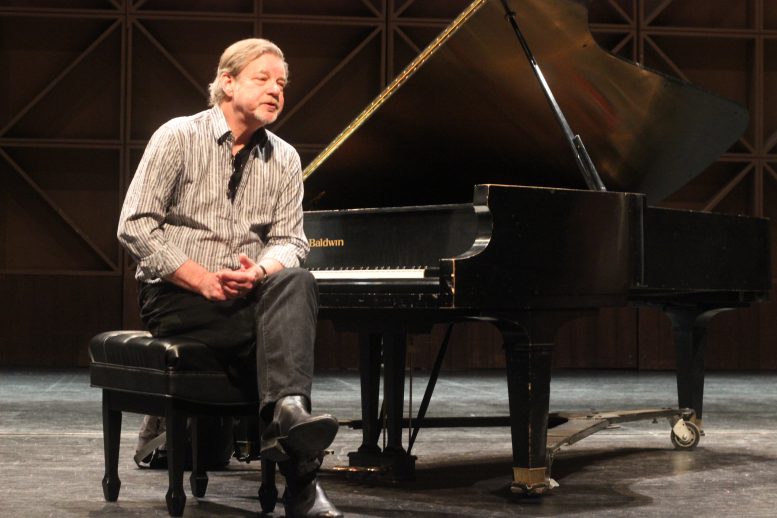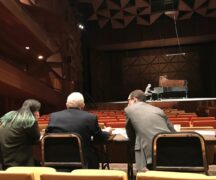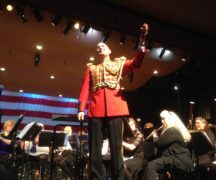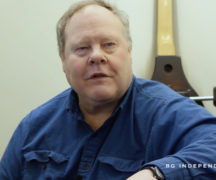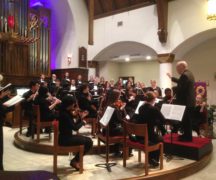By DAVID DUPONT
BG Independent News
Jazz is not all about you.
From junior high into college jazz teaching emphasis how to play loud, fast, and high, said Frank Kimbrough, a veteran jazz pianist.
What’s important, he said, was “how to play with the cat standing next to you and make him sound good.”
Kimbrough is the visiting artist for jazz week at Bowling Green State University which culminates with his performance with the Jazz Lab Band I, tonight (Thursday, March 12) at 8 p.m. in Kobacker Hall. The concert will be the last musical performance on campus until at least April 6 because of concern about the coronavirus that can cause COVID-19.
On Wednesday, Kimbrough shared stories of his life in jazz. It’s been a charmed life, he said, and in many ways improbable.
Since 2008 he’s taught at Juilliard where he rides the elevator with and hosts the greatest musicians in the world. Not bad for someone without a college degree, he said.
Kimbrough grew up in a small town North Carolina that didn’t have a club, or a record or bookstore. But he started playing piano young. At 4, he said, he’d hear a tune in church and then just work it over on the piano at home. He was improvising, not that he knew what that was.
Now, 63, he grew up loving the Beatles, Led Zeppelin, and Steppenwolf. He played in rock bands, and studied piano.
In high school, he knew he didn’t want to be a classical pianist, and the rock bands didn’t hold his interest. Those three basic chords “only go so far.”
Then one night he heard the piano great Bill Evans perform on TV. That, he said, planted the seed.
By the early 1980s, he was in New York City.
His wonderful life included working with some of the greats of the previous two generations.
He played with saxophonist Dewey Redman, known for his avant garde work with jazz visionary Ornette Coleman. Their first gig was a bar mitzvah, playing on a patio — a favor to the doctor who Redman credited with saving his life. Later they did play at the Montreal Jazz Festival.
He’s performed with Lee Konitz, now 92, who sings parts of his solos because he doesn’t have the dexterity to play them, but the greatness is still there.
He also worked with drummer Paul Motian, who’d worked with the Bill Evans Trio. Kimbrough tagged along as much as he could with pianists Paul Bley and pianist Andrew Hill.
For 26 years he’s been the pianist in the Maria Schneider Orchestra, the world’s leading big band. Kimbrough recalled that he’d gotten this call from this composer from Minnesota who wanted him to play a gig. The packet of music and a recording arrived at the club where he was performing four sets with “a bad singer.” One set with a bad singer is too long, and four was interminable.
He had low expectations for this music he’d been handed. “I expected it would be the cherry on top of a bad night,” he said. But when he got home at 2 a.m. he put the recording on and heard Schneider’s ballad “Evanescence.” He knew this was a gig he wanted to take.
He’s been on every Schneider recording since, including her orchestral work with Dawn Upshaw, and the band’s recording with David Bowie of “Sue (Or In a Season of Crime).”
He joined a band stocked with many of New York’s musical finest including tenor saxophonist Rich Perry and trumpeter Tim Hagans, both BGSU graduates.
Perry is a musician who can be extremely hard on himself. Musicians like John Coltrane and Sonny Rollins practiced incessantly, always striving to get better.
Others embrace more care-free approach.
For players such as Bley and Hill “spontaneity is everything.”
Bley would say: “Practice makes perfect, but imperfection is better.”
They didn’t do second takes.
Kimbrough recalled talking to Hill about a recording session he was about to do. The younger pianist was angling for an invitation to the studio. Having determined what studio he’d be at, he asked Hill when the session would start. At 3, the elder musician said. Kimbrough then asked how long will it go till? 3:30, Hill answered.
That sense of spontaneity was on display when Kimbrough joined the jazz faculty for a concert Wednesday in Bryan Recital Hall.
The sextet with Jeff Halsey, bass, David Bixler, alto saxophone, Charles Saenz, trumpet, Ariel Kasler, guitar, and Dan Piccolo, drums, performed four songs — the hard bop flag waver “Prince Albert,” “November,” a moody original by Kimbrough, Hill’s impressionistic “Dusk” with Thelonious Monk’s buoyant “Let’s Cool One” to close. Kimbrough interjected a probing trio version of Rodgers and Hart’s “Nobody’s Heart.”
The audience wanted more, so Kimbrough wandered back out. Halsey was starting to pack up his bass, but Kimbrough had other ideas. He suggested they play a duet.
Echoing what he’d said earlier about Bley’s approach to playing standards, he started to play waves of rhapsodic lines over some familiar harmonies with only the slightest hint of the melody. As he approached the middle of the form, he caught Halsey’s eye. They slipped into an easy swing. After Halsey played a deft solo, Kimbrough went back into free time, with Halsey’s eyes locked on him, dropping the bass notes that led to the resolution of a beautiful rendition of “Body and Soul.”
Tonight’s concert will include big band arrangements, several by Bixler, that capture the range of Kimbrough’s projects.
There’ll be a few Kimbrough originals, Monk’s “Ask Me Now” (Kimbrough most recent project is a six-disc recording of all Monk’s compositions) and one of Maria Schneider’s compositions.
Then Kobacker and the other campus venues will enter a season of silence.

